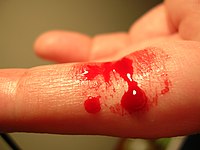
Photo from wikipedia
Punt et al. describe nearly universal heavy menstrual bleeding among women with suspected or confirmed congenital platelet disorders (CPD). They further describe the negative impact of excessive vaginal blood loss… Click to show full abstract
Punt et al. describe nearly universal heavy menstrual bleeding among women with suspected or confirmed congenital platelet disorders (CPD). They further describe the negative impact of excessive vaginal blood loss on health-related quality of life and sexual functioning. They found that treatment of excessive vaginal bleeding was effective at improving quality of life with many requiring surgical intervention. However, despite the high prevalence of heavy vaginal bleeding with menstruation, childbirth and miscarriage, they found that treatment was not universally provided. Female participants from the TiN (Thrombocytopathy in the Netherlands) cross-sectional nationwide study were invited to participate in this project, which collected data on bleeding using the International Society on Thrombosis and Haemostasis (ISTH) Bleeding Assessment Tool (ISTH-BAT) and the Pictorial Bleeding Assessment Chart (PBAC). Treatment history and social activities were recorded as well as the SF-36 (Short-Form) for quality of life. Of the159 women who participated in the TiN study, 102 consented to this study, and an impressive 78 completed all assessments and were included in the analysis, reflecting the high level of interest in the subject. Of these, 35 were women with a confirmed CPD and 43 had suspected CPD. Fully 68/78 (87%) reported heavy menstrual bleeding at some point in their life. It is not surprising that heavy menstrual bleeding is so prevalent among women with suspected or confirmed CPD nor is it surprising that it has multifaceted downstream negative effects. What should come as a surprise however, is that in 2021 this prospective cohort study of 102 women is one of the largest reports describing these phenomena. Also, it is surprising that treatment of excessive vaginal blood loss was not universally applied in this cohort. Structural sexism in medicine negatively affects women’s health and in particular, the management of women with bleeding disorders. Medical sexism seeps into the subconscious of the patient and health care provider alike, rendering compounded discomfort and compounded knowledge gaps. How are patients expected to have an awareness of normal vaginal bleeding if they have only ever known heavy bleeding? How are we to make headway if mothers and daughters do not have open conversations about menstruation? How are we to encourage these conversations when vaginal bleeding remains culturally stigmatized in the 21st century? How are we to treat patients who never present to medical care because of the entrenched stigma? How are health care providers expected to have meaningful discussions with patients about vaginal bleeding if the topic is not explicitly taught in general medical education curricula? How are health care providers expected to advance care when publications on menstruation are not prioritized? How are leaders in medicine who prioritize women’s health to emerge if there are so few to model and emulate? How are health care providers expected to effectively implement treatment when there is inequitable and geographically variable access to pads, tampons, menstrual cups, oral contraception, tranexamic acid, and iron replacement therapy? What is needed is ongoing mainstream description of the lived experiences of women with bleeding disorders, and acceptance and de-stigmatization of vaginal bleeding to help lift barriers in access to care for these patients. What is needed is ending period poverty with universal access to products that allow for normal functioning in response to a physiological insult. What is needed is prioritized publication of manuscripts describing the findings of studies like those of Punt and colleagues, and deliberate invitation of scientific reviewers to write commentaries that help amplify the significance of the work. What is needed is continued promotion of women as leaders in science and medicine. What is needed are ongoing efforts to provide guidance to Correspondence: Michelle Sholzberg, St. Michael’s Hospital, Departments of Medicine, and Laboratory Medicine and Pathobiology University of Toronto, Toronto, Ontario, Canada. E-mail: [email protected] commentary
Journal Title: British Journal of Haematology
Year Published: 2021
Link to full text (if available)
Share on Social Media: Sign Up to like & get
recommendations!